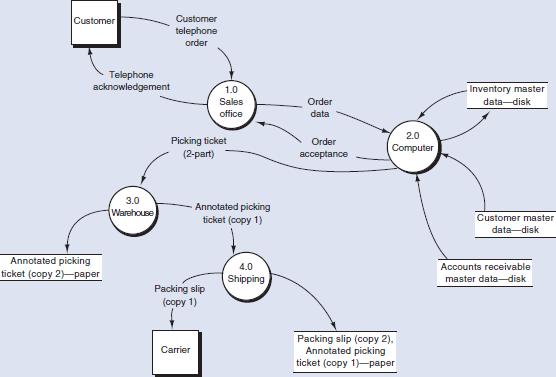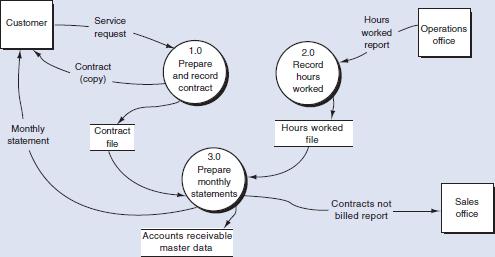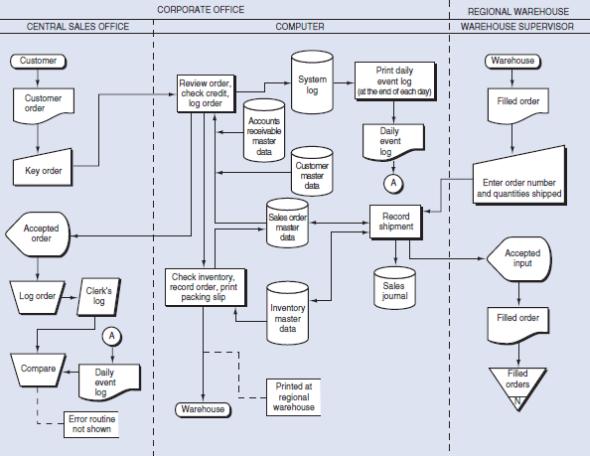Question
These problems are based on the following narratives of processes in three fictional companies. Wonderful Stuff Inc. describes the sales process at wonderful-stuff.com. Erickson, Inc.
These problems are based on the following narratives of processes in three fictional companies. Wonderful Stuff Inc. describes the sales process at wonderful-stuff.com. Erickson, Inc. is a monthly cash receipts process. Trillium Insurance Company describes an automobile insurance order entry and billing system. If you want to test your documentation skills beyond these problems, there are narratives at the end of Chapters 10 through 14.
FIGURE 4.14 Physical DFD for Problem 4-1
 FIGURE 4.15 Logical DFD for Problem 4-2
FIGURE 4.15 Logical DFD for Problem 4-2
 FIGURE 4.16 Flowchart for Problem 4-3
FIGURE 4.16 Flowchart for Problem 4-3

Wonderful Stuff, Inc. (wonderful-stuff.com)
Wonderful Stuff, Inc. (a fictitious company) sells a variety of consumer products through its Web site, wonderful-stuff.com. Wonderful Stuff’s IT infrastructure consists of a front-end Web server that interacts with customers and a back-end ERP system that manages the inventory and performs other typical ERP functions. The sales order process begins when a customer logs on to the wonderful-stuff.com Web site. The Web server requests the current Wonderful online catalog from the ERP system, which sends the catalog to the Web server, and the server displays it to the customer. The customer selects the items and quantities that he wants to purchase; the Web server edits the customer input for accuracy (e.g., ensures that all required fields have been selected or filled in) and sends this list on to the ERP system where the requested quantities of inventory are allocated for the sale. The ERP sends back to the Web server the quantities that have been allocated, and the Web server displays this information on the customer’s screen. The customer verifies that the order is correct and completes the sale by entering his shipping and credit card information. The Web server edits this data for accuracy (e.g., ensures that all required fields have been selected or filled in and that the length of entered credit card number is correct) and sends the credit card information and amount of the sale on to the credit card company. The credit card company sends back a verification number, and the Web server notifies the customer that the sale has been completed by displaying a confirmation number on the customer’s screen. The Web server also notifies the ERP system that the sale has been completed, and the ERP system changes the status of the inventory from allocated to sold, prints a picking ticket/packing slip in the warehouse, and records, on the enterprise database, a sale and an accounts receivable from the credit card company.
Erickson, Inc.
Erickson, Inc. sells plumbing supplies to contractors in the northeast region of the United States. Each month, the IT division at Erickson prints monthly statements and sends them to the accounts receivable (AR) department where a clerk mails them to the customers. Erickson’s customers mail their payments back to Erickson where a clerk in AR batches the checks and sends them to the cashier. The AR clerk then uses the payment stub to enter the payments into the computer where the AR master data is updated to record the payment.
Trillium Insurance Company
Trillium Insurance Company of Newton, Massachusetts, processes its automobile insurance policies on a batch-oriented computer system with magnetic disk storage. Customers send requests for auto insurance into the Newton sales office where sales clerks prepare policy request forms. They file a copy of the form and forward the original to the input preparation section where data entry clerks use networked PCs to key and key-verify the data contained on the documents to a disk (“policy requests”).
Each evening, computer operations retrieves the policy request data from the network, edits the data on the computer for accuracy (e.g., all required fields completed), sorts the data in policy number sequence, and prints a summary report listing the edited policy requests (there is an error routine, not described here, for those requests that do not pass the computer edits). The summary report is sent to the sales office where the sales clerks compare the report to the copy of the policy request form that they previously filed. If everything checks out, they notify computer operations to go ahead with processing. When notified, computer operations processes the correct policy request data against the policyholder master data to create a new policy record. Each evening, a disk, which was created during the processing run, is used to print premium notices that are sent to the customer.
a. Prepare an annotated table of entities and activities based on the output from Problems 4-4 and 4-5. Indicate on this table the groupings, bubble numbers, and bubble titles to be used in preparing a level 0 logical DFD.
b. Prepare a logical DFD (level 0 only) based on the table you prepared in part (a).
Customer Telephone acknowledgement Annotated picking ticket (copy 2)-paper 3.0 Warehouse Customer telephone order 1.0 Sales office Picking ticket (2-part) Annotated picking ticket (copy 1) 4.0 Shipping Packing slip (copy 1) Carrier Order data Order acceptance 2.0 Computer Packing slip (copy 2), Annotated picking ticket (copy 1)-paper Inventory master data-disk Customer master data disk Accounts receivable master data-disk
Step by Step Solution
3.40 Rating (153 Votes )
There are 3 Steps involved in it
Step: 1
a Annotated tables of entities and activities Annotated tables of entities and activities should be ...
Get Instant Access to Expert-Tailored Solutions
See step-by-step solutions with expert insights and AI powered tools for academic success
Step: 2

Step: 3

Ace Your Homework with AI
Get the answers you need in no time with our AI-driven, step-by-step assistance
Get Started


